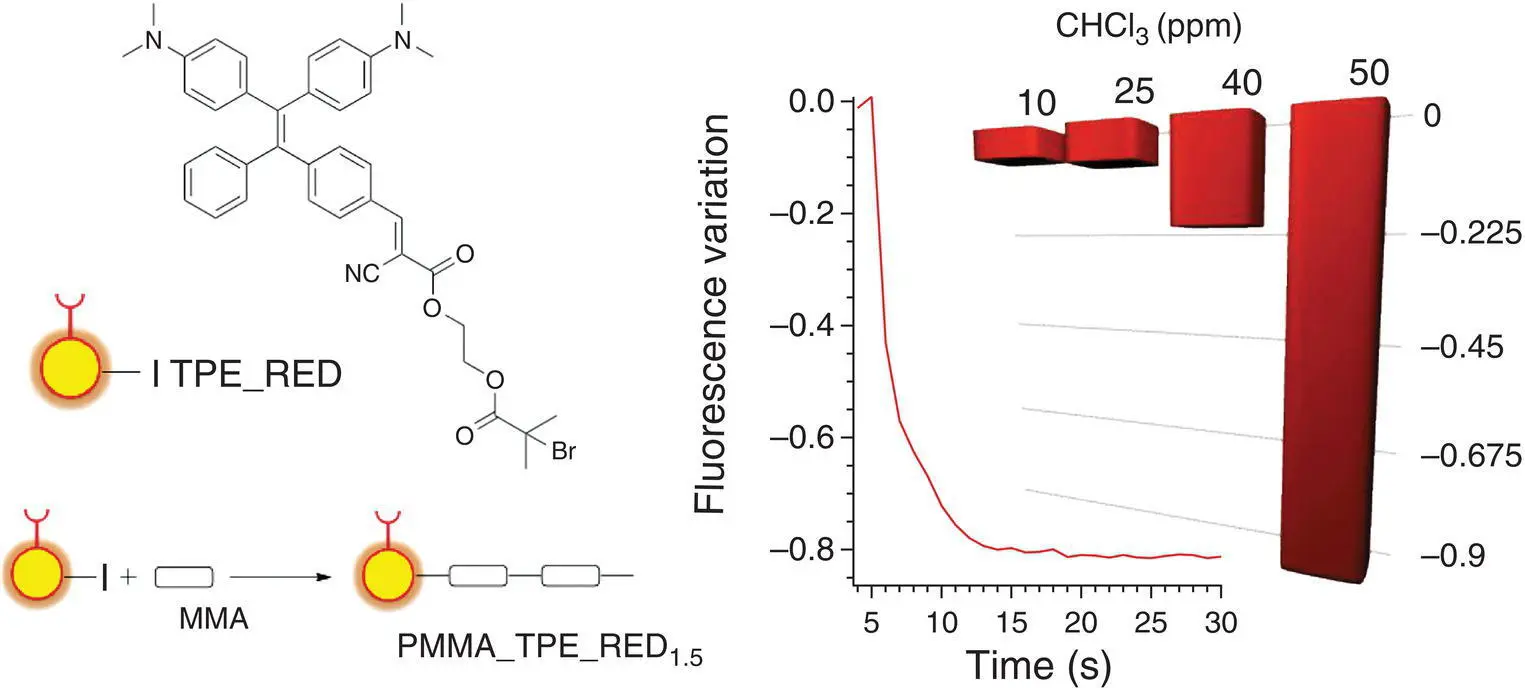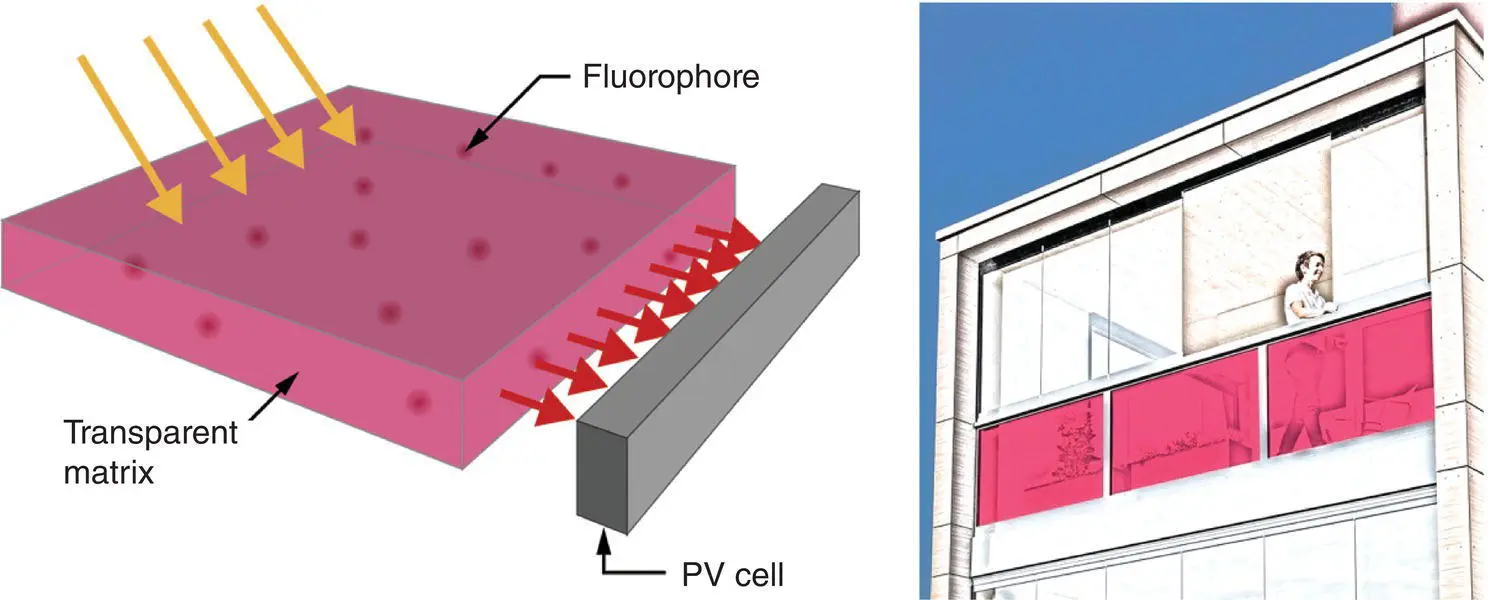In connection with these findings, Sorgi et al. [67] lately proposed two strategies in one FMR: covalent‐linking the fluorophore and the polymer matrix and using perfluorinated moieties to selectively distribute the FMR near the film surface. On this basis, new fluorinated styrene‐based block copolymers were prepared and labeled by a small amount (i.e. 0.11–0.13 mol.%) of the julolidine‐based FMR probe. Spray‐coating of the AIE‐doped fluorinated copolymers over the surface of a PS film yielded two‐layer films, in which the segregation of the perfluorinated tails bearing the AIE probe occurred at the polymer–air interface. Physical proximity of the probe FMR to the air–polymer surface enables the film to show fast and highly sensitive response toward VOC exposure. Notably, the vapochromic response of these sensing films was at least six times more rapid than the previous outcomes and with sensitivity toward chloroform vapors of about 25 ppm.
Following the general idea of boosting vapochromic features of AIE‐doped films by the covalent incorporation of the fluorescent probes, Guidugli et al. proposed to design a new TPE molecule with donor–acceptor features and a 2‐bromo‐2‐methylpropanoate unit used as the initiator to prepare red‐emitting poly(methyl methacrylate) polymers (PMMA_TPE_RED 1.5) via atom transfer radical polymerization (ATRP) [86]. The sensing performances of the spin‐coated films (thickness of 2 μm) demonstrated significant vapochromism when exposed to VOCs characterized by high vapor pressure and favorable interaction with the polymer matrix such as chloroform, acetone, and toluene. According to the authors’ explanation, the empty channels and holes of the polymer are progressively filled by vapors of solvents, thus causing a rapid decrease in microviscosity. This phenomenon caused the prompt deactivation of the TPE probe, its phenyl rings being allowed to rotate around the stator, thus provoking a strong drop at the emission during VOC exposure. Noteworthily, PMMA_TPE_RED 1.5films displayed substantial vapochromism already in the presence of 10 ppm of CHCl 3vapors, which is the highest sensitivity reached by such a kind of AIE‐doped plastic films ( Figure 3.10).

Figure 3.10 Chemical structures of TPE_RED and PMMA_TPE_RED 1.5AIE‐doped polymers, fluorescence variation of the maximum intensity with exposure time to a saturated atmosphere of chloroform, and maximum fluorescence variation plotted as a function of CHCl 3vapor concentration after 200 seconds of exposure.
The sensibility of AIEgens with FMR characteristics toward VOCs when embedded into polymer films stimulated the group of Tang to develop a visualizing system based on fluorescence to transform the invisible information of relative humidity (RH) into an optical output of different colors [87]. In this regard, cationic AIE‐active TPE derivatives (i.e. TPE‐Py and TPE‐VPy) were utilized as FMRs with TICT effect and physically blended into poly(acrylic acid) (PAA), a well‐known host polymer matrix for high water absorptivity and excellent film/fiber‐forming capability.
The authors demonstrated that as RH increased, the emission maxima experienced a progressive quenching flanked by a red‐shift, the latter with a linear progression with the RH content within the entire 0–99% range. The behavior is mainly due to the presence of highly polar water molecules surrounding the AIEgens, which are TICT. The higher the humidity, the higher the polarity. Thus, the TICT molecules twist toward the TICT state, showing a redder emission when the humidity increases. Notably, the emission maximum of the AIE‐doped PAA film red‐shifted and is flanked by a progressive drop of the intensity in agreement with the formation of the TICT state. Moreover, aiming at enhancing sensitivity and response rate, the excellent filmability of the PAA matrix allowed the formation of films with diverse geometries, architectures, and porosities, i.e. taking advantages of the electrospinning technique. Noteworthily, electrospun films were demonstrated to provide a striking vapochromic response to human breath within one second and to effectively detect the presence of a finger in a contactless way.
3.4 AIE‐doped Polymer Films for Energy Harvesting
Recently, high‐quantum‐yield ( Φ F) AIEgens have also been utilized as solar‐harvesting species dispersed into polymers for the preparation of LSCs [88–93]. Sunlight concentration is one of the most effective strategies to reduce the price of electrical power generated by silicon‐based PV solar cells [94]. It is reported that compared to imaging concentrators based on lenses and mirrors, nonimaging LSC demonstrates several advantages, such as low weight, high theoretical concentration factors, ability to work well with diffuse light, and no need for sun tracking or cooling apparatuses [95, 96]. LSCs were first conceived more than 50 years ago by Garwin [97, 98] and are made by a slab of a highly transparent material like glass or plastics like PMMA, PC, or epoxy resins doped by a certain content of a fluorophore. The light that enters the slab is absorbed by a luminescent species and is re‐emitted at longer wavelengths. Because the refractive index of the slab is higher ( n = 1.5 for glass or PMMA) than that of air ( n = 1), a fraction (theoretically about 75%) of the radiation remains trapped within the matrix due to total internal reflection (TIR) and concentrated at the edges of the plate. PV cells glued at such edges collect the outgoing radiation and produce electric power ( Figure 3.11).

Figure 3.11 Working mechanism of an LSC (left) and potential application of the PSC–PV systems in the urban architecture.
Notwithstanding the importance of these plastic solar collectors to diffuse the use of PVs in the urban environment, their utilization is limited due to waveguide losses that adversely affect light concentration to PV cells. LSC loss of performances is often attributed to fluorophore issues including fluorescence quenching due to aggregation and autoabsorption losses [96, 99]. Commercially available aromatic fluorophores display a tendency to π ‐stack, which affects their emission quantum efficiency due to the typical ACQ phenomenon at large content. A low‐fluorophore concentration in the polymer film or slab is considered useless, its capability to harvest sunlight being modest. For example, the perylene bisimide Lumogen F Red 305 (BASF) is considered the best fluorophore for LSCs [96], but cost issues might also limit the diffusion of the LSC–PV technology. Conversely, fluorophores with AIE characteristics would be the best candidates for the LSC systems since highly emissive polymer blends can be effectively obtained even at large fluorophore concentration, thus favoring the required solar‐harvesting features [100]. Moreover, the easy chemical modification of several AIE cores opens to economic and scalable synthetic routes that enable the functionalization of the AIE unit with donor–acceptor functional groups. This strategy favors the downshifting of the fluorescence maximum in order to cover the wavelength window characterized by the highest light/electric current conversion by the Si‐based PV cell [101]. In connection with these findings, a red‐emitting TPE derivative (TPE‐AC) was proposed for the first time in a proof‐of‐concept study as a potential AIEgen for the development of high‐performance LSC [42, 102, 103]. The red‐emitting TPE was composed of donor dimethylamine and acceptor malononitrile groups and showed intense emission in the aggregated state close to the near‐infrared (NIR) wavelength window and a good photostability [104]. Different TPE‐AC‐doped PMMA and PC films were prepared and tested as a function of the AIEgen content. Owing to the higher TPE‐AC compatibility within the PC matrix, well‐homogeneous films with superior light‐harvesting features were gathered and with maximum optical efficiencies of 6.7%. This data resulted in promising but still lower than those recorded in the literature for the traditional fluorophore‐based LSC. The same approach was adopted by Ghiggino et al. [105–107] who proposed the dispersion of 10 wt.% of TPE in PMMA thin films, reaching Φ Fof about 40% and very low autoabsorption losses even at a geometric factor ( G ) >100. Nevertheless, the formation of organic microcrystals of TPE strongly contributed to the formation of scattering points that affected the overall LSC performances. In order to increase the LSC performances, the same authors [108] introduced two different fluorophores in the same solar collectors in order to combine their absorption spectra and preserving Φ Fby means of efficient energy cascade pathways such as the fluorescence resonance energy transfer (FRET) [109–112]. As designed, a strong‐emitting AIEgen was able to transfer its excitation to an acceptor whose red‐shifted emission strongly reduced the dissipative autoabsorption phenomena, thus enhancing solar‐harvesting and LSC performances [106].
Читать дальше














